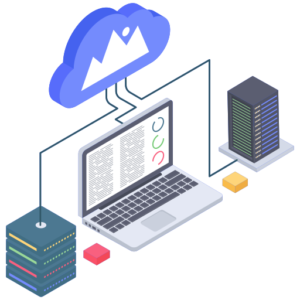
Internet of Things (IoT) paradigm refers to the network of physical objects or “Things” embedded with electronics, software, sensors, and connectivity to enable objects to exchange data with servers, centralized systems, and/or other connected devices based on a variety of communication infrastructures.
 Internet of Things (IoT) could be a revolution within its creation. additional things and additional devices have gotten connected to the web more than individuals. It goes on to mention that over twenty-five billion devices are expected to be connected by the year 2016 and over fifty billion are slated to be connected by the year 2020. Forecasts by McKinsey &Company estimate that the economic impact of IoT technology by year a pair of025 can vary from 2.7 to 6.2 trillion bucks. Adoption of IoT for areas as well as home observation and management, wearable technologies, and connected cars has already started.
Internet of Things (IoT) could be a revolution within its creation. additional things and additional devices have gotten connected to the web more than individuals. It goes on to mention that over twenty-five billion devices are expected to be connected by the year 2016 and over fifty billion are slated to be connected by the year 2020. Forecasts by McKinsey &Company estimate that the economic impact of IoT technology by year a pair of025 can vary from 2.7 to 6.2 trillion bucks. Adoption of IoT for areas as well as home observation and management, wearable technologies, and connected cars has already started.
When IoT is increased with sensors and actuators, IoT is in a position to support cyber-physical applications in that networked objects will impact the physical atmosphere by taking “physical” actions. IoT can usher automation in a very sizable amount of domains, starting from production and energy management (e.g. sensible Grid), to attention management and concrete life (e.g. sensible City). At the enterprise level, adoption is active for building management, fleet management, hospital management, retail, telecom, and energy sectors. Operational technology has been long adopted by Power Grids, Oil & Gas, Utilities, Nuclear Plants, and control.
IoT is chop-chop evolving, at the same time, IoT devices that connect with the web are exponentially increasing the attack surface for hackers and enemies. In recent studies, it’s emerged that seventy p.c of IoT devices contain serious vulnerabilities. there’s associate degree plain proof that our dependence on interconnected technology is defeating our ability to secure it.
Despite the large positive impact IoT has on the lives of people, the risks that accompany this technology will act as a big hurdle in its adoption. Security problems in IoT are particularly some extent of concern as they need the facility to cause physical destruction, damaged lives, and conjointly cause monetary impact. There’s no denying the importance of IoT security. relying upon the trade and application, corporations victimization IoT technology are in danger of possible exposure to a spread of threats stemming from hacktivism, terrorism, and cyber warfare.
Privacy could be a serious concern not simply within the IoT, but altogether the applications, devices, or systems wherever we have a tendency to share info. Even once users take precautions to secure their info, there are conditions that are on the far side of their management. Hackers will currently craft attacks with unexampled sophistication and correlate info not simply from public networks, but conjointly from totally different non-public sources, like cars, smartphones, home automation systems, and even refrigerators.
Risks of IoT
IoT risk issue is exclusive since it brings along several forefront technologies as well as cloud computing, quality, and massive knowledge, in addition, to IoT sensors, gateways, and management platforms. IoT security, therefore, includes risk areas that cyber security trade remains learning to resolve and cloud and quality. IoT security conjointly includes unknown risk areas within the kind of IoT sensors, protocols, gateways, and management platforms. augment this with the regular IT systems that IoT platforms integrate with and you get a fancy mixture of risk areas that ought to be protected.
 IoT devices don’t have well-outlined perimeters, are extremely dynamic and endlessly amendment owing to quality. additionally, IoT systems are extremely heterogeneous with relevant communication mediums and protocols, platforms, and devices. IoT systems may additionally embody “objects” not designed to be connected to the web.
IoT devices don’t have well-outlined perimeters, are extremely dynamic and endlessly amendment owing to quality. additionally, IoT systems are extremely heterogeneous with relevant communication mediums and protocols, platforms, and devices. IoT systems may additionally embody “objects” not designed to be connected to the web.
IoT can additionally complicate the cyber security challenges that we have a tendency to have already got at hand, as well as the challenge of detective work unknown attacks. The OWASP web of Things (IoT) Project has known the commonest IoT vulnerabilities and has shown that a lot of such vulnerabilities arise owing to the dearth of adoption of well-known security techniques, like coding, authentication, access management, and role-based access management.
OWSAP list of vulnerabilities is as follows:
Insecure internet interface
Insufficient authentication or authorization
Insecure network services
Lack of transport coding
Privacy issues
Insecure cloud interface
Insecure mobile interface
Insufficient security configuration
Insecure software system or computer code
Poor physical security
A reason for the dearth of adoption could definitely be security unknowingness by IT corporations concerned within the IoT house and by end-users. However, one more reason is that existing security techniques, tools and merchandise might not be simply deployed to IoT devices and systems, for reasons like the variability of hardware platforms and restricted computing resources on many sorts of IoT devices. Even well-known coding protocols, like RSA, convince be terribly big-ticket once running on devices with restricted computing capabilities particularly once multiple coding operations ought to die at the same time like in the case of networked vehicles and tiny drones.
A recent study in a {number of} the foremost common IoT devices reveals an associate degree alarmingly high average number of vulnerabilities per device. On a median, twenty-five vulnerabilities were found per device. as an example, eightieth of devices did not need passwords of adequate quality and length, seventieth failed to cipher native and remote traffic communications, and hour contained vulnerable user interfaces and/or vulnerable computer code.
Changing Canvas of Cyber Attacks in IoT
Cyber Attacks in IoT devices disrupt traditional operations by exploiting vulnerabilities and victimization numerous techniques and tools. associate degree attacks themselves could be available in several forms, as well as active network attacks to watch un-encrypted traffic in search of sensitive information; passive attacks like observation unprotected network communications to rewrite debile encrypted traffic and obtain authentication information; close-in attacks; exploitation by insiders, and so on. Common cyber-attack varieties are:
(a) Physical Attacks: thanks to the unattended and distributed nature of the IoT, most devices usually operate in outside environments, that are extremely prone to physical attacks.
(b) reconnaissance mission Attacks: assailant will un-authorized scanning of network ports, packet sniffers, traffic analysis, and cause queries concerning information science address info.
(c) Denial-of-Service (DoS): thanks to low memory capabilities and restricted computation resources, the bulk of devices in IoT are liable to resource enervation attacks.
(d) Access Attacks: There are 2 differing types of access attacks viz -physical access, whereby the unwelcome person will gain access to a physical device and second is remote access, which is completed to IP-connected devices.
(e) Attacks on Privacy: Privacy protection in IoT has become more and more difficult thanks to massive volumes of knowledge simply out there through remote access mechanisms. the foremost common attacks on user privacy are:
 Data mining
Data mining
Cyber espionage
Eavesdropping
Tracking
Password-Based Attacks
Dictionary Attack
Brute force Attacks
Supervisory management and knowledge Acquisition (SCADA) Attacks: Like the other TCP/IP systems, the SCADA system is prone to several cyber-attacks. The system is attacked in any of the subsequent ways:
Using denial-of-service to finish off the system.
Using Trojans or viruses requires management of the system. for example,
in 2008 associate attack was launched on an associate Iranian nuclear facility in Natanz employing a virus named Stuxnet.
Cyber Security Measures for IoT
To succeed with the implementation of economical IoT security, the following security measures ought to be incorporated:
Confidentiality is a crucial security feature in IoT, however, it’s going to not be obligatory in some eventualities wherever knowledge is conferred in public. for example, patient knowledge, personal business knowledge, and/or military knowledge likewise as security credentials and secret keys, should be hidden from unauthorized entities.
To provide reliable services to IoT users, integrity may be an obligatory security property in most cases. completely different systems in IoT have varied integrity necessities. for example, an overseas patient observation system can have high integrity checking against random errors thanks to data sensitivities. Loss or manipulation of information might occur thanks to communication, doubtless inflicting loss of human lives.
Authentication and Authorisation. present property of IoT aggravates the matter of authentication due to the character of IoT environments, wherever attainable communication would crop up between device to device (M2M), human to the device, and/or human to human. {different|totally completely different|completely different} authentication necessities necessitate different solutions in numerous systems. Some solutions should be sturdy, for instance, authentication of bank cards or bank systems. On the opposite hand, most can need to be international, e.g., ePassport, whereas others need to be native.
Availability. A user of a tool (or the device itself) should be capable of accessing services anytime, whenever required. completely different hardware and code elements in IoT devices should be strong and therefore offer services even within the presence of malicious entities or adverse things. for example, fireplace observation or tending observation systems would possibly have higher accessibility necessities than wayside pollution sensors.
Accountability. once developing security techniques to be utilized in a secure network, responsibility adds redundancy and responsibility of sure actions, duties, and designing of the implementation of network security policies. responsibility itself cannot stop attacks however is useful in making certain the opposite security techniques area unit operating properly.
Auditing. thanks to several bugs and vulnerabilities in most systems, security auditing plays a crucial role in determining any exploitable weaknesses that place the info in danger. In IoT, a system would like for auditing depends on the appliance and its price.
Non-repudiation. The property of non-repudiation produces sure proof in cases wherever the user or device cannot deny associate action. Non-repudiation isn’t thought about as a crucial security property for many IoT. it’s going to be applicable in sure contexts, for example, payment systems wherever users or suppliers cannot deny a payment action










